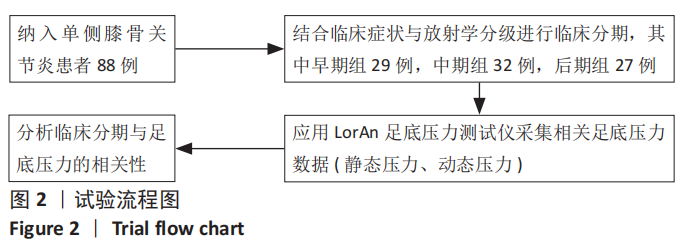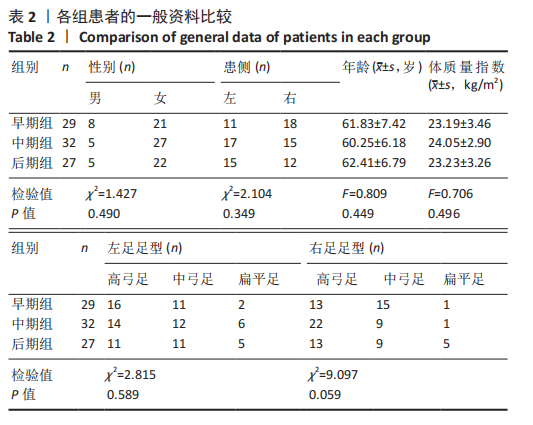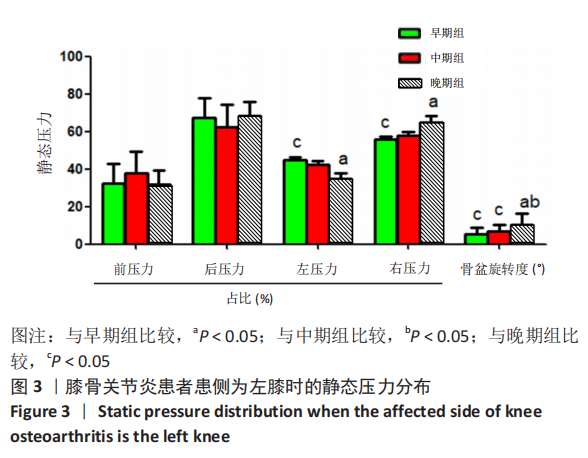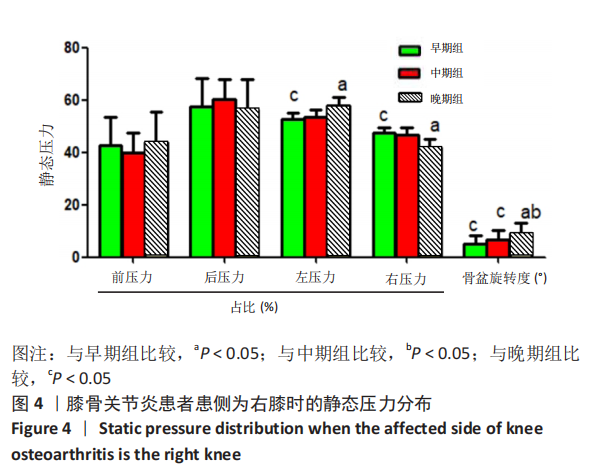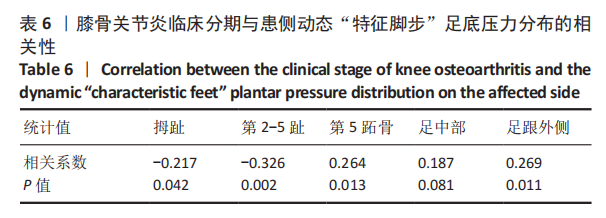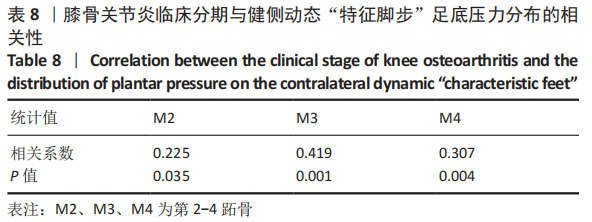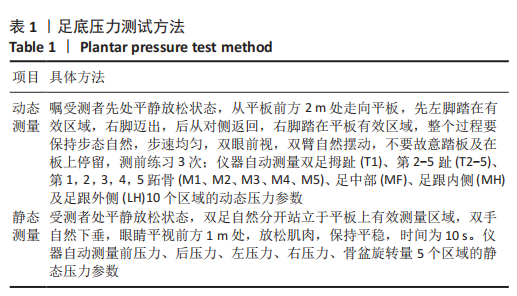中国组织工程研究 ›› 2021, Vol. 25 ›› Issue (27): 4312-4317.doi: 10.12307/2021.188
• 骨与关节生物力学 bone and joint biomechanics • 上一篇 下一篇
单侧膝骨关节炎临床分期与双足足底压力的相关性
王 欣,罗 文,黄文泽,许燕飞,艾元亮,夏煜博,周晓寒,王 涛,郭 英
- 1昆明市中医医院呈贡院区,云南省昆明市 650500;2云南中医药大学,云南省昆明市 650500;3昆明市中医医院,云南省昆明市 650000
Correlation between clinical stage of unilateral knee osteoarthritis and double plantar pressure
Wang Xin, Luo Wen, Huang Wenze, Xu Yanfei, Ai Yuanliang, Xia Yubo, Zhou Xiaohan, Wang Tao, Guo Ying
- 1Chenggong Branch, Kunming Hospital of Traditional Chinese Medicine, Kunming 650500, Yunnan Province, China; 2Yunnan University of Chinese Medicine, Kunming 650500, Yunnan Province, China; 3Kunming Hospital of Traditional Chinese Medicine, Kunming 650000, Yunnan Province, China
摘要:
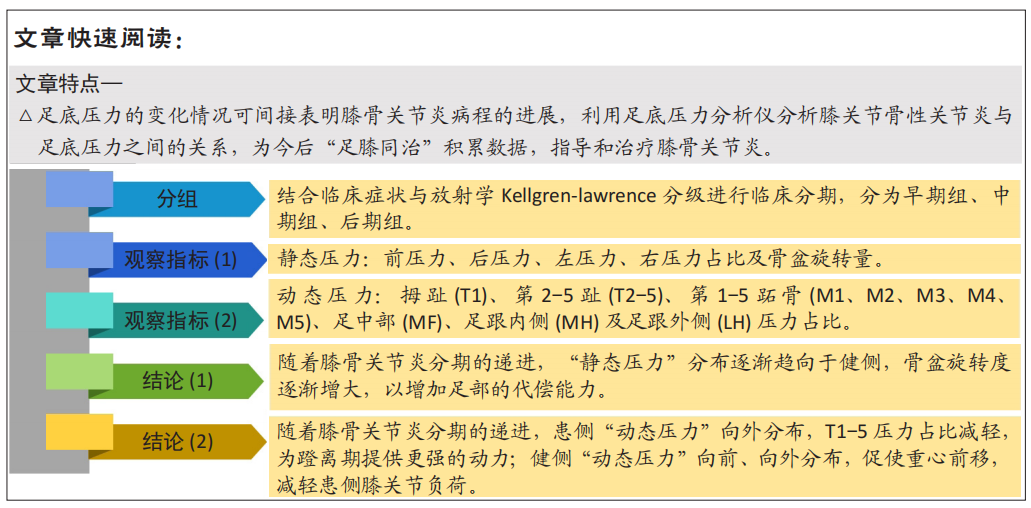
文题释义:
膝骨关节炎:是由关节软骨退化开始的一系列关节退行性改变所导致的关节炎症,伴随着年龄的增长发病率逐渐增加;临床常表现为疼痛、肿胀、僵硬、活动受限,日久可见关节畸形等症状。
足底压力:是人体在静止站立或者动态行走时,在自身重力的作用下,足底在垂直方向上受到的一个地面的反作用力。足底压力测定是步态分析的一个重要组成部分,是分析和衡量异常足底应力分布和步态的基础,它对运动系统病的病因分析、诊断、功能及恢复成果评定均有重要意义。
背景:足底压力是人体在静止站立或者动态行走时,在自身重力的作用下,足底在垂直方向上受到的一个地面反作用力。通过对膝骨关节炎不同分期的足底压力进行相关性分析,可以为膝骨关节炎早期干预和指导调理提供证据。
目的:观察单侧膝骨关节炎不同分期的足底压力变化,为单侧膝骨关节炎病情发生发展提供足底压力变化的相关依据。
方法:收集2018年10月至2019年12月云南中医药大学第三附属医院骨伤科收治的单侧膝骨关节炎患者,结合临床症状与放射学Kellgren-lawrence分级进行临床分期,其中早期29例,中期32例,后期27例。通过LorAn足底压力测试仪采集足底压力,其中静态压力数据包含前压力、后压力、左压力、右压力占比及骨盆旋转量;动态压力取“特征脚步”数据,包含拇趾、第2-5趾、第1-5跖骨、足中部、足跟内侧及足跟外侧压力占比;分析临床分期与足底压力的相关性。
结果与结论:①3组患者在静态压力分布中的左压力、右压力、骨盆旋转量相比差异有显著性意义(P < 0.05);3组患者的动态“特征脚步”中患侧拇趾、第2-5趾、第2跖骨、第5跖骨、足跟外侧压力及健侧第2跖骨、第3跖骨、第4跖骨压力相比差异有显著性意义(P < 0.05);②静态压力中左压力、右压力、骨盆旋转量及动态“特征脚步”患侧第5跖骨、足中部、足跟外侧压力、健侧第2跖骨、第3跖骨、第4跖骨压力与临床分期进展呈正相关(P < 0.05);③静态压力中左压力、右压力及动态“特征脚步”患侧拇趾、第2-5趾压力与临床分期进展呈负相关(P < 0.05);④有序多元Logistic回归分析显示,“特征脚步”患侧第2-5趾、第5跖骨、足跟外侧压力及健侧第3跖骨压力为膝骨关节炎临床分期的独立影响因素(β=-0.329,0.333,0.199,0.654;P < 0.05);⑤结果表明随着膝骨关节炎分期的进展,“静态压力”分布逐渐趋向于健侧,骨盆旋转度逐渐增大,以增加足部的代偿能力;患侧“动态压力”向外分布,拇趾、第2-5趾压力占比减轻,为蹬离期提供更强的动力;健侧“动态压力”向前、向外分布,促使重心前移,减轻患侧膝关节负荷。
https://orcid.org/0000-0001-9924-8441 (王欣)
中国组织工程研究杂志出版内容重点:人工关节;骨植入物;脊柱;骨折;内固定;数字化骨科;组织工程
中图分类号:
